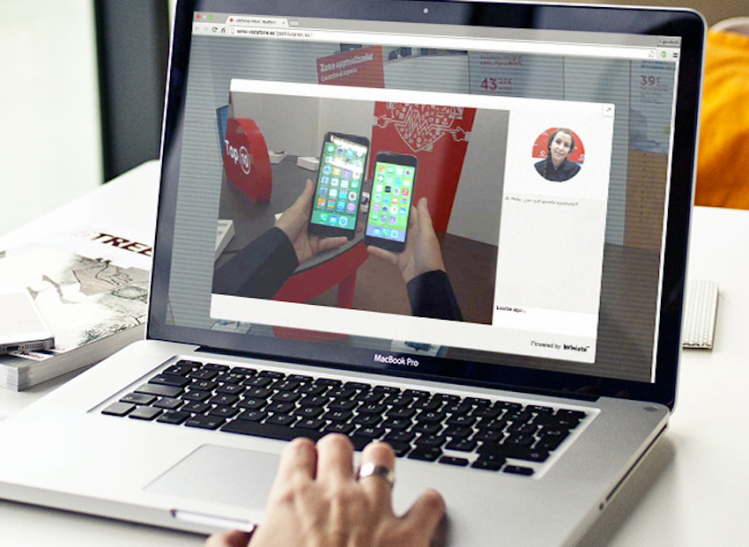Someday, it will seem quaint that a store’s website and its physical location once occupied different worlds.
Actually, that day may be here.
Barcelona-based Whisbi, which for the past seven years has been providing online video calls from salespeople to help website visitors, is now extending that service to virtual store visits through wearable video devices.
It’s “a revolutionary omnichannel software-as-a-service technology,” VP of global sales and marketing Luigi Mallardo told me from Spain, via the same system.
“Can you imagine a physical store without store assistants?” he asked.
“Then why shouldn’t e-shops have them? Why [is] sales conversion per visit much lower on e-shops compared with physical stores? Is it because [of] the lack of this human touch?”
He described his company, which also has offices in London, Madrid, and Sao Paolo, as “the only company in the world making a bridge between ecommerce and the retail store experience.”
A visitor on a Whisbi-enhanced website clicks on a “Need more help?” or similarly labeled button. The visitor can enter a phone number, and the system will call both the visitor and the sales rep in the store. Or the website visitor can call a Whisbi phone number, and the system automatically connects the rep.
The rep is then shown in a one-way live video from the retail store or showroom. The visitor is not shown.
VentureBeat is studying social media marketing.
Answer our survey now and we’ll share the results with you.
In Whisbi’s telepresence incarnation, the rep is wearing Google Glass, Epson Moverio smart glasses, or the camera in an Android smartphone, possibly on a lanyard around the rep’s neck or with the camera end of the phone sticking out of a shirt pocket. The rep can then walk through the showroom, picking up and demonstrating new products in live point-of-view video.
The rep can also show a Web page — to indicate where a desired product can be found online, for instance — or can show a file or live app. The system also supports a text chat and the ability for file transfer between visitor and rep.
https://www.youtube.com/watch?v=IJsd_ZMdyns&feature=youtu.be
Showrooms just for websites?
The visitor can have any kind of phone, and any computer setup with browser and Internet connection. No special plugins or downloads are required, and, since a phone is used and there’s no video of the visitor, the website visitor needs neither camera nor speakers.
Whisbi has been offering this point-of-view service for retailers in Europe since September. Vodafone, Fiat and Telefonica are clients, and Whisbi says they have doubled their sales conversion as a result.
“A key point,” Mallardo said, “is that if you show your product, conversion rate increased.”
The service is now available in the U.S. but has not yet implemented. Mallardo told me the company is in discussions with several U.S. retailers.
While a variety of companies offer click-to-call functions on their websites, and some offer the ability to click for a live video of a sales rep — including Amazon’s Mayday button for Kindle devices — Mallardo says he is unaware of any other company that offers this kind of click-for-telepresence from the showroom or retail store.
The company has received two U.S. patents, and two are pending. They cover synchronization between computer transmissions and phone audio, transmission of video using very low connection speeds, and other aspects.
If showrooms with telepresence catch on, Google Glass and other wearable video devices could dramatically change the current interaction between ecommerce sites and their physical stores.
Although some marketing platforms have been attempting to add real-world store environments to their tools via iBeacons, point-of-sale interaction, geofencing, and the like, the website version of a retailer and the physical store version still represent very different experiences. The ability to see remotely into a store or showroom, essentially through the eyes of a knowledgeable, live store rep as he walks around and demonstrates products, could provide a new kind of experiential tunnel connecting store and website.
In fact, Mallardo envisions companies building real showrooms exclusively for support of their ecommerce sites, which could expand each website by the unique qualities of the remote location. Or, if the website uses existing physical stores, the brick-and-mortar property could find a new reason for being.
Pricing for the service ranges from $250 per rep per month for a smartphone video version and $500/rep/month for the Google Glass or Epson glasses version. Hardware for the rep, such as Google Glass, is not included in that price.
VentureBeat's mission is to be a digital town square for technical decision-makers to gain knowledge about transformative enterprise technology and transact. Learn More

